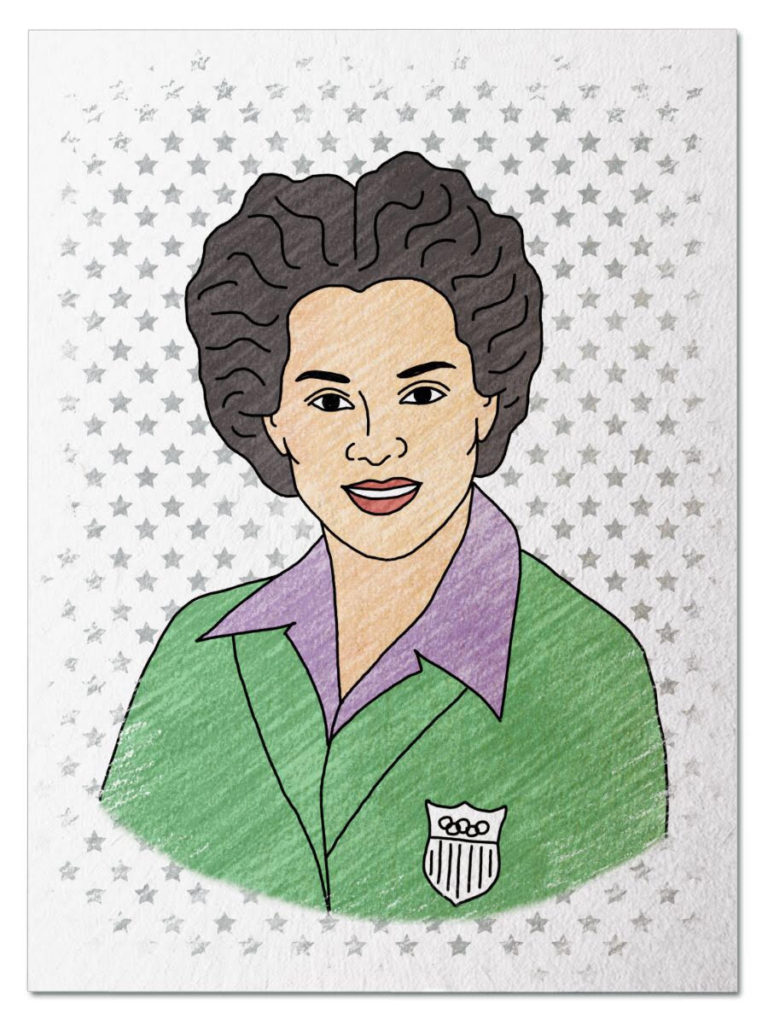
Awesome Athlete
Growing up without much money in San Francisco, she spent her days at the public pool. For 5 cents a day, she learned to swim and eventually worked up the courage to try the diving board. When she was 16, a friend asked if was interested in trying competitive diving, and she decided to try it. The first coach willing to take a chance on her saw her potential, but his club didn’t allow non-white athletes to compete. So he created a separate club – in name only – for her. The rest of her story made Olympic history. Rewind to the 1948 London Olympics and step onto the diving board with Vicki Manalo Draves…
Her Ruby Shoe Moment
The Power of the Wand
Her Yellow Brick Road
Brains, Heart & Courage
Glinda’s Gallery
Just the Facts
Her Ruby Shoe Moment
Victoria Manalo Draves stood at the base of the 3 meter springboard. The moment she had been training for was finally here: her first dive in her first event in the 1948 London Olympics.
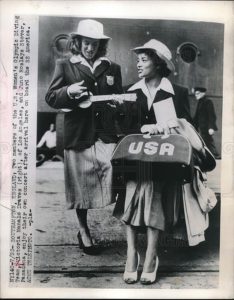
Vicki and teammate arriving in London for the Games. (Wikimedia Commons)
The Olympic experience so far had been exciting and a bit overwhelming. It was Vicki’s first time traveling internationally. The Olympic committee paid for first class cabins on their ship, but asked the divers to compete in their own swimsuits! They were staying in dorm rooms at Southland College in Wimbledon and shuttled to practice at Wembley Stadium by English women who the government initially employed as drivers during World War II.
The Opening Ceremonies was one of the most emotional moments of Vicki’s life. Walking into the stadium with thousands of athletes from around the world inspired a wave of patriotism and gratitude for the opportunity to compete for the United States.
Vicki was not the favorite in the springboard event. American diving superstar Zoe Ann Olsen was difficult to beat. Vicki had only done it once before, at the 1948 U.S. Championships. More recently, at the Olympic trials, Zoe Ann had bested Vicki again.
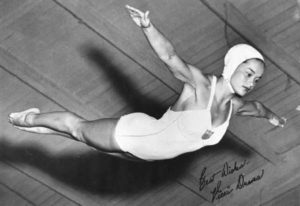
Vicki mid swan dive (Crescenta Valley Historical Society)
Olympic competition rules were different from U.S. events. Instead of preliminaries and finals, Olympic springboard was one round of 8 dives, 4 per day. There were also stricter limits on using difficult dives to get higher scores. The only way to stand out was to do each dive absolutely perfectly.
Vicki stepped onto the springboard, cleared her mind, and let her body take over. And at the end of Day 1, Vicki was in first place. Back at the athlete dorms, while many congratulated her, Zoe Ann reminded her that the champion was decided after Day 2. In bed that night, Vicki prayed for calm and mentally walked through her dives to prepare.
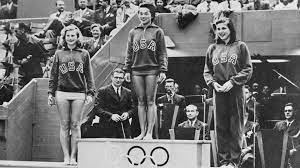
Vicki wins the Gold! It was an American sweep. (U.S. Olympic Commmittee)
Day 2 was tough. Vicki shook with nerves between her dives. Zoe Ann closed the gap with Dives 5 and 6, and took the lead after Dive 7. Vicki felt doom – her Dive 8 was a back 1 ½ layout that she had been missing in practice all week. She sought out her friend, diver Sammy Lee, and told him her fears. His response: “you came all this distance and you are going to give up? Get up there and do what you are supposed to do.”
And Vicki did. Underwater, she knew the dive was perfect. She had done her best and it was in the judges’ hands. Her score put her ahead of Zoe Ann by .51 of a point. The gold was hers. The medal ceremony took place immediately after the competition, and Vicki reveled in the pride and joy of hearing the Star Spangled Banner play in honor of her efforts.
There wasn’t much time to enjoy the moment. With the platform competition next, the press started speculating about Vicki’s change to make history as the first woman to win gold in both events. Vicki was the platform favorite as the Olympic trials and two-time U.S. champion. The pressure was intense to perform as expected, and her nerves increased with each passing day.
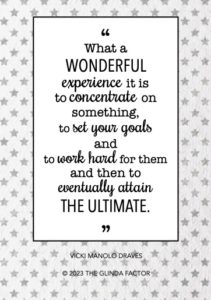 The platform competition was one round of 6 dives. Vicki started strong with Dives 1 and 2. Then her concentration slipped with Dives 3 and 4. She roared back with Dive 5 – a beautiful flying forward 1 ½. With one dive left and the lead, Vicki was on the cusp of an unprecedented second gold.
The platform competition was one round of 6 dives. Vicki started strong with Dives 1 and 2. Then her concentration slipped with Dives 3 and 4. She roared back with Dive 5 – a beautiful flying forward 1 ½. With one dive left and the lead, Vicki was on the cusp of an unprecedented second gold.
Dive 6 was a reverse dive. Vicki’s nerves kicked in again and she forgot the step in her hop, skip and jump. Her last thought as her body left the platform was “I’m going to miss this dive.” She had a split second to recover for the mistake while in the air and somehow did, entering the water beautifully. She came up for air to the sight and sound of the 6000 person audience giving her a standing ovation. The gold was hers.
The Power of the Wand
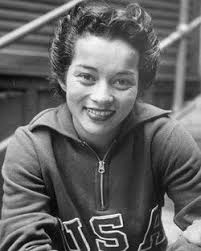 Vicki grew up in an era where swimming and diving was a segregated activity. Most pools set limited hours for people of color and drained and cleaned the pool immediately afterwards.
Vicki grew up in an era where swimming and diving was a segregated activity. Most pools set limited hours for people of color and drained and cleaned the pool immediately afterwards.
Vicki was the first woman to win both springboard and platform gold medals in the same Olympic games. She also was the first Asian American to win an Olympic medal. Her accomplishment was headline news worldwide. Life Magazine named her one of Team USA’s best athletes.
Her Yellow Brick Road
Vicki start diving lessons when she was 16, after a friend helped set up a tryout with Coach Phil Patterson at the Fairmont Hotel Swimming & Diving Club. He saw her potential and agreed to train her. But there was one roadblock: the governing board of the Club prohibited non-white divers. Phil set up a separate club, in name only, for Vicki – the “Patterson School of Swimming & Diving.”
Phil worried that prejudiced judges might penalize her because Manalo was a Filipino name. Vicki reluctantly agreed to use her mom’s maiden name and compete as Vicki Taylor, but the switch didn’t last long. In her first interview, she forgot her “new” name and introduced herself as Victoria Manalo.
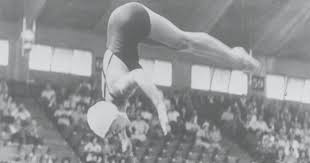
Vicki in competition (U.S. Olympic Committee)
Phil had a big team, with not much time for individual instruction. He told Vicki to learn her list of dives by shadowing another diver. Vicki chose Helen Crienkovicht, the reigning National Champion. Vicki mastered the swan dive and jackknife; and was working on reverses and twists when World War II changed everything. Phil entered the military and the club disbanded.
Vicki missed diving, and started again after being inspired by a newspaper picture of a former teammate who was now diving in college. She found a new team and resumed competing in springboard events. Her biggest challenge was mental – she had to work hard at blocking outside thoughts and trust her muscle memory.
Once Vicki got her nerves under control, she consistently finished in the top 3. She competed in her first National competition when she was just 19. The 3 day train trip to Indiana was Vicki’s first time leaving California. Vicki competed in 3 meter springboard and was happy with her third place finish.
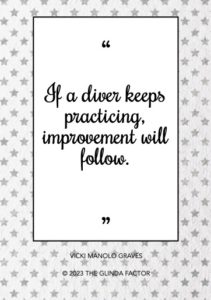 Her next big meet was the Indoor Nationals back in California, where her friend Sammy Lee introduced her to well-known diving coach Lyle Draves, who was coaching superstar Zoe Ann Olsen. When Vicki’s coach retired shortly after the meet, she asked Lyle to be her coach and he agreed.
Her next big meet was the Indoor Nationals back in California, where her friend Sammy Lee introduced her to well-known diving coach Lyle Draves, who was coaching superstar Zoe Ann Olsen. When Vicki’s coach retired shortly after the meet, she asked Lyle to be her coach and he agreed.
At their first practice, Lyle told Vicki that while she had natural talent, she lacked diving fundamentals, and would never beat divers like Zoe Ann without them. If she wanted to be a champion, she needed to start from scratch, as if she was a child just learning to dive. Her first practice focused solely on board work – the walk, arm movements and jumps.
Vicki took time off from competition to focus on mastering the mechanics, and didn’t debut her new skills until the 1945 Internationals at Chicago’s Tower Club. It was an impressive venue – the pool was on the 19th-23rd floors with huge windows overlooking the city. Vicki finished second to Zoe Ann in both the 1 meter and 3 meter springboard events.
Vicki was tired of being a runner up – she wanted to win! Back home, she redoubled her efforts. She worked all day, trained with Lyle for a few hours, went home for dinner, and met Sammy Lee at a public pool for more practice. Each night she fell into bed exhausted and then did it all again the next day.
And then right before Outdoor Nationals, Lyle, who worked for a Navy contractor, was transferred to Los Angeles. Vicki didn’t want to lose her coach as she was on the cusp of a championship, so she moved too. She also decided it was time to start platform diving so she could enter all diving events offered and make moving across the state worth it.
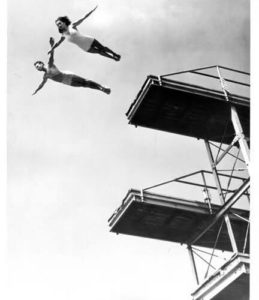
Lyle and Vicki doing a tandem swan dive off the platform
Vicki’s first attempt at platform didn’t go well. She stood on the 16 foot platform for 30 minutes trying to will herself off the board. She ended up climbing back down to the swim deck to take some deep breaths. It took a few tries, but she eventually worked up the courage to dive. She loved the flying sensation and learned to tolerate how much more it hurt to hit the water from such great heights.
At the 1945 Nationals, Vicki entered all springboard and platform events. She finished higher in platform, placing second to Helen by only .09 point. She occupied her usual 3rd spot in springboard, with Zoe Ann again finishing first.
Vicki and Lyle got married in July 1946, right before Nationals in Indiana. Her wedding present to herself was the championship she had been seeking – a first in platform! In springboard she fell short to Zoe Ann again, finishing second. She returned to California more determined than ever.
Brains, Heart & Courage
Vicki grew up in San Francisco. Both of her parents were immigrants – her mom from England and her dad from the Phillipines. Interracial marriages were both rare and frowned upon, creating some difficulties for their family, which included Vicki and her two sisters.
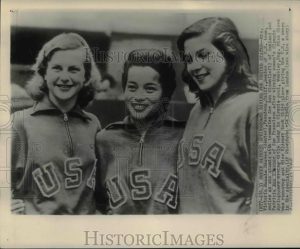
Vicki with Zoe Ann Olsen & Patsy Elsener (Wikimedia Commons)
Young Vicki loved dancing and gymnastics. Her family couldn’t afford gymnastics lessons, so she spent school recess practicing cartwheels and handstands. The “family fun” budget was limited, so they spent much of their free time at the “nickle baths” in the Mission District. For just 5 cents each, Vicki and her twin, could have a full day of splashing in the pools there. They walked over in the morning, packed a lunch for the picnic area, and stayed for afternoon swimming lessons sponsored by the Red Cross.
Initially Vicki was afraid of deep water, but by age 9 was swimming on her own. She ventured over to the deep end to watch the brave kids launch themselves off of the diving board. It was so similar to gymnastics that Vicki was intrigued. She eventually worked up the courage to start diving herself, first forward and then backwards.
 As the Manolo girls grew up, there was a little more money to spare, which meant more activities to take up their time. Vicki kept busy with badminton, softball, cheerleading, and a modern dance class. But they still spent summer days in the water, hopping on a streetcar to the Flieshacker Pool – two big rectangles of salt water connected by a circular bowl in the middle. One rectangle was shallow for splashing and sunning. The other end was deep, with a low springboard, high springboard, and diving platform.
As the Manolo girls grew up, there was a little more money to spare, which meant more activities to take up their time. Vicki kept busy with badminton, softball, cheerleading, and a modern dance class. But they still spent summer days in the water, hopping on a streetcar to the Flieshacker Pool – two big rectangles of salt water connected by a circular bowl in the middle. One rectangle was shallow for splashing and sunning. The other end was deep, with a low springboard, high springboard, and diving platform.
Vicki’s older sister had discovered diving and trained with her friends at Flieshacker. When the divers weren’t in the water, they practiced their acrobatics on the side lawn. Vicki, still in love with gymnastics, joined them for that part of their training, just for fun. One of the boys said she had the skills to become a a good competitive diver and asked her if she was interested. She said yes and he introduced her to his coach at the Fairmont Swimming & Diving Club.
Glinda’s Gallery
Just the Facts
- Vicki was born on December 31, 1924 in San Francisco, California.
- Vicki retired from amateur competition after the Olympics. She accepted roles as a featured diver in a few different touring water shows and traveled around the country performing with other well-known swimmers and divers. She became so famous she even received movie offers from Hollywood!
- In 1958, Vicki and Lyle moved to Encino, California to start a swimming and diving training center. They raised their 4 sons there, all of whom became competitive divers.
- Vicki died on April 11, 2010. She was 85.
Want to Know More?
Draves, Vicki; Costa, Margaret. “An Olympian’s Oral History” (LA 84 Foundation Dec. 1999).
Francisco, Eric. “Why Vicki Draves’ Story is So Powerful 72 Years Later” (Inverse Aug. 3, 2020).
Staff. “Vicki Draves Overcame Segregation to Make a Name for Herself” (U.S. Olympic & Paralympic Museum).
